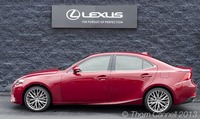2014 Lexus IS 250, IS 350 Transformation - It IS Competitive At Last
2014 Lexus IS 250 and IS 350 Review
By Thom Cannell
Senior Editor
Michigan Bureau
The Auto Channel
 |
Seats, softly tanned a shade of terra cotta called Rioja Red, were comfortable and supportive without restricting our shoulders, the fold-down arm rest hit just under the elbow and we still had hip room. Leg room, increased by 1.6” this year, felt larger and longer even for the tall guy. We thought there could be a touch more room to squeeze toes under the front seats, also lowered by 20 mm as Lexus worked diligently to increase the connectedness of driver to the car. They lowered the steering wheel similarly.
 |
 |
It’s not that engines have been doped by some arcane Japanese alchemist shooting up nitromethane or plumbing in nitrous oxide tanks, rather it is a chassis structure metamorphosis. This mutation allows the smaller engine to perform so well that, with F-Sport package and Levinson sound, the IS 250 might be the better choice for anyone who won’t track the car. Of course there is no such thing as too much horsepower. It is this revised chassis that renders Lexus competitive against Audi's A4 and BMW's 3-Series.
Simply put, the chassis is held together better. Race cars derived from production models are first stripped bare and every seam welded to provide rigidity. Lexus uses meter after meter of adhesive bonding like Boeing’s 777 plus laser screw welding, laser welding between traditional spot welds, borrowed from the flagship LS. The resulting vehicle stiffness is Lexus-like in quietness, now with race car stiffness. All of that makes the redesigned suspension with multilink rear, gas dampers, and inboard coil springs largely taken from the GS sedan, work more smoothly. Actually, spring rates are down a few percent while damping or shock absorption is tuned firmer. F Sport models have electronically controlled damper valving. You’ll like the 2014 IS regardless which vehicle you specify.
 |
Let's drill down a bit into the various models. There are four basic models, IS 250 RWD and AWD (which Lexus calls All Weather Drive) and similar versions of the more powerful IS 350. However there are rear wheel and all wheel drive F Sport versions of each, the F Sport being an option package not an engine or transmission variation. F Sport variants are by far the most desirable for performance enthusiasts.
IS 250s are powered by a 2.5-liter 4GR-FSE V-6 with 204 horsepower and 185 pound feet of torque, which is excellent in class for a non-turbo engine and couples to a 6-speed automatic transmission with selectable gears. IS 350’s 2GR-FSE engines displaces 3.5-liters and creates 306 horsepower using both direct injection and port injection. It produces 277 pound feet of torque, pretty good for the engine size. In RWD 350 F Sports it’s coupled to an 8-speed automatic derived from the IS-F sports model, AWD models stick with 6-speeds even if F Sport.
Interiors are more comfortable and extremely functional in their controls with high mounted navigation screen. Choices of color themes vary between black, dark gray, wood (it wouldn’t be a Lexus without wood), or organically etched silver for F Sports. Lexus did make a huge faux pas, heated seats are only available in AWD models and heated steering wheels, heated rear seats are nowhere to be found.
There are two instrument panels, an Optronic with large master gauges and center information display. F Sport models Bogart an LF-A supercar-style center cluster with fly out information panels. You’ll just have to see the pictures, better yet a YouTube video or dealer visit. We particularly liked the touch sensitive hot-cold manual control; it is raised about 2 mm and you can feel it as you slide the temperature up or down. Actual degrees are registered in the display, or optional navigation screen and dual zones are standard.
Underlying safety electronics are abundant with every alphabet item: ABS, Lane Departure Warning, Blind Spot Detection, Cross Traffic Detection, Dynamic Cruise Control, Pre-CollisionSystem, Tire Pressure Monitoring, Adaptive Variable Suspension Variable Gear Ratio Steering, the list is endless and of course some features are optional parts of the Luxury package or F Sport package. In addition there are ten standard air bags to offer protection from impact if the brakes, your eyes and other safety warnings are ignored.
 |
 |
All of Lexus’ familiar luxury, supported by a massive array of awards from Wards Engines to JD Power and beyond is now bolstered by a chassis that can challenge Europe’s best. Take our word or visit the dealer. We suggest a test drive.



